- Home
- Encyclopedia
- The Oil Business In Wyoming
The Oil Business in Wyoming
The oil industry has been a part of the Wyoming economy since the beginning days of statehood. As far back as the early 19th century explorers in what is now Wyoming reported evidence of oil. In 1832, when fur trader Capt. B. L. E. Bonneville traveled to the Wind River Valley, he found oil springs southeast of present Lander near Dallas Dome, where the state’s first oil well would be drilled five decades later.
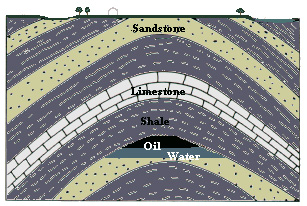
During the fur trade and Overland trails periods, travelers commented on “oil springs” where oil bubbled to the surface of water pools. For centuries, native people seined off the oil, using the greasy residues for war paint, decoration on hides and teepees, horse and human liniments and other medications. An oil spring near Hilliard in present Uinta County was well known when Fort Bridger was established nearby in 1842.
The first recorded oil sale in Wyoming occurred along the Oregon Trail when, in 1863, enterprising entrepreneurs sold oil as a lubricant to wagon-train travelers. The oil came from Oil Mountain Springs some 20 miles west of present-day Casper.
Nationally, oil had a similar history. Thirteen years after the world’s first oil well was drilled in Baku, Azerbaijan, on the Caspian Sea, America’s first gusher was struck. Made by “Colonel” Edwin Drake, America’s initial discovery was at Titusville, Pa., in 1859. It led to an oil rush to western Pennsylvania. Initially, even the newly “drilled” oil had only nominal use in transportation—as axle grease for wagons and coaches or lubricant for steam engines powered by wood or coal.
Early Wyoming discoveries
In 1866, John C. Fiere, an employee of Fort Bridger Sutler William A. Carter, reported to his boss that he had found oil nearby. He had experience in the Pennsylvania oil fields and offered to develop the oil spring commercially. In the following years, the spring produced 150 barrels of oil. The entire amount was sold to the Union Pacific Railroad.
In the spring of 1867, Judge C. M. White dug a hole next to the oil spring where Carter’s employees had been skimming oil from the surface of the water. White’s crew scooped oil from hand-dug trenches. He shipped modest amounts to Salt Lake City tanners until the transcontinental railroad passed nearby the following year, giving him additional markets for lubrication.
By comparison, Wyoming’s first commercial coal mines also opened in the late 1860s to fuel the Union Pacific Railroad. Coal remained vastly more important than oil to Wyoming’s economy for the rest of the century.
About the time of Drake’s Titusville discovery, meanwhile scientists found that a petroleum by-product, kerosene, could provide superior lighting to candles. The newly developed kerosene lamps gave off even better light than those that burned increasingly costly whale oil. Indeed, whales were becoming scarce and, were it not for kerosene, their extinction could have been a possibility.
In 1870, Cleveland merchant John D. Rockefeller formed a company he called Standard Oil. A purchaser of Rockefeller's kerosene, sold in one- or five-gallon blue cans, could be assured that the product contained no water or explosive gasoline that sometimes was dishonestly passed off as kerosene by other merchants. Gradually, through sound business deals as well as anticompetitive practices, Rockefeller gained near monopoly over oil in the Northeast.
When Thomas Edison invented the first practical incandescent light bulb in 1879, observers believed Rockefeller’s oil business would wither and die. But despite the seeming ruinous competition from electric lighting, Rockefeller persevered. In 1883, he and his partners expanded combined operations across several states into the Standard Oil Trust.
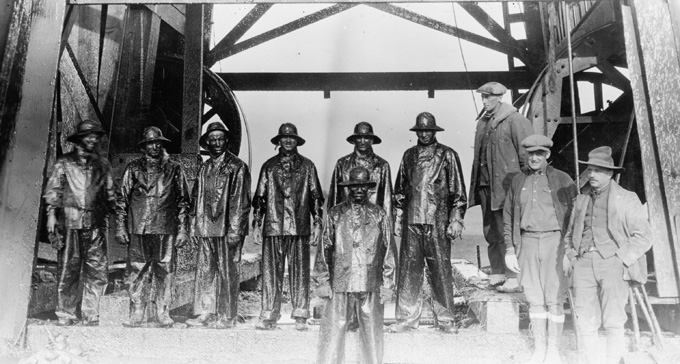
Well drilling begins
That same year, out west, Mike Murphy brought in Wyoming Territory’s first drilled oil well at Dallas Dome, finding oil at 300 feet in the Chugwater formation. (A dome is a geological formation that traps oil underground between impervious layers of rock, with the upper layer bent upward to form a dome.)
Markets for the unrefined petroleum were limited. Apparently, like Carter and White two decades earlier, Murphy sold most of his production to Utah tanners and to the Union Pacific to lubricate railcar axles. Electricity generation proved impractical for tiny towns and ranches, particularly in Wyoming where distances between ranches were great. Kerosene continued its dominance in rural lighting.
Soon after Murphy’s successful well, others entered the business. Cy Iba, a former gold prospector, started drilling for oil around Casper. Several others attracted investment to possible oil strikes in the Big Horn Basin at Bonanza, northeast of present Worland and in southwestern Wyoming around Hilliard and Mountain View. Iba’s first strike, “Discovery Well” north of Casper, began transforming that newly established, wool-shipping railhead into the “oil capital of the Rockies.”
In the 1890s, significant oil strikes were made in northern Natrona County. Investors, comfortable with dependable nearby supplies of crude oil, underwrote construction of Wyoming’s first refinery in 1895. Pennsylvania investors headed by Philip Shannon formed the firm at Casper and named it the Pennsylvania Refinery. They also struck oil at what became known as the Shannon Field north of Casper.
A new demand for gasoline
Kerosene and lubricating oils remained the primary petroleum-based products in demand, but that soon was about to change. In May 1898, Laramie bicycle shop owner Elmer Lovejoy ordered a one-cylinder, two-cycle marine engine. When it was delivered, Lovejoy assembled the combustion engine and mounted it and the frame on four bicycle wheels.
While American forces were winning the 14-week Spanish-American War in Cuba and the Philippines, Lovejoy’s “toy” clattered along the unpaved streets of Laramie, going five miles per hour in one forward gear and 10 mph in a second, but with no reverse. Of course, the single-seat runabout engine was fueled by gasoline, formerly a waste product dumped by refiners into nearby streams in earlier years.
Wyomingites began purchasing automobiles in 1900 and by the end of the decade, cars were commonplace throughout the state. Medical doctors often were the first people in towns to buy cars. In Rawlins, Dr. John Osborne brought a car to town in 1900. Two years later, Dr. W. W. Crook became the first Cheyenne resident to own a car. Dr. J. L. Wicks had Evanston’s first car in 1906.
Several sheep ranchers were owners of early cars. In Fremont County, J. B. Okie pioneered motor vehicles at his ranch, “Big Teepee,” at Lost Cabin. John Sedgwick brought the first car to Weston County, driving his Model N Ford to and from his sheep ranch in 1905. Sheepman William Ayers owned Platte County’s first car. Automobiles became so widespread in the following decade that the first state speed limit of 12 mph maximum in towns was imposed in 1913. In the same year, the state required for the first time that all cars be licensed.
Demand for better roads
In order to drive the rather primitive motor vehicles around the state, Wyomingites became vitally concerned with road improvements. As a consequence, counties started grading roads. “Good roads associations” formed nationwide and lobbied for better highways. The Lincoln Highway (U.S. Highway 30) became the nation’s first designated transcontinental automobile route.
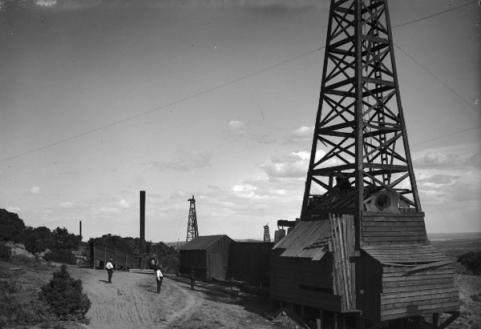
In 1917, the Wyoming Legislature created the Wyoming Highway Department and named various routes as state highways. Years later, in the 1950s, Congress authorized interstate highways and, eventually, Interstate 80 followed roughly the route of the Lincoln Highway across southern Wyoming.
Wyoming refineries
During those early years, car owners purchased gasoline in gallon or two-gallon cans from general stores. The date of Wyoming’s first gasoline station is not known, but refineries produced gasoline in abundance by the late 19-teens. In 1917, five refineries were operating in the state, including small operations at Greybull and Cowley.
By 1923, Casper alone boasted five refineries—the tiny Pennsylvania Oil and Gas Company facility on South Center Street built in 1895; the Belgo-American refinery later known as the Midwest Refinery built east of Highland Cemetery in 1903; the giant Standard Oil refinery in southwest Casper, opened in March 1914 and expanded in 1922 into the largest gasoline-producing refinery in the world; the Texaco refinery, three miles east of Casper that opened in 1923; and the small White Eagle refinery opened the same year.
The early 1920s were the heyday of Wyoming oil production and refining. Numerous wells were in production in the Big Horn Basin, in the Oregon Basin, Elk Basin, Greybull, Garland and Grass Creek fields. In eastern Wyoming, the Lance Creek field near Lusk was one of the state’s largest, causing the town of Lusk to grow to an estimated population in excess of 5,000 people by the early 1920s.
Oil had been found on part of the University of Wyoming’s land grant, meanwhile, near Glenrock in 1916. Royalties from the production from the “university well” in the Big Muddy field made it possible for the institution’s administrators to stave off the bad economic conditions of the 1920s and build the Half Acre Gymnasium and the university library, now the Aven Nelson Building.
Important refineries popped up throughout the state. The Producers and Refiners Company (PARCO) built a refinery and a complete town for its employees on the Union Pacific line in Carbon County in 1923. When the firm went into bankruptcy in the early 1930s, oilman Harry Sinclair bought the town on April 12, 1934, and renamed it Sinclair.
Boom-time Casper
An active stock exchange, known as the Midwest Oil Exchange, operated in Casper, Wyoming’s “oil city.” There, on the corner of Second and Center streets, speculators could trade “penny stocks”—cheap shares worth a few cents each—offered by fledgling companies eager to attract sufficient investors so that the businesses could buy equipment and lease lands where they could “strike it rich.”
Close to the stock exchange and numerous oil company offices, a red-light district known as the Sandbar flourished in the 1920s. Well-known gambling and prostitution houses operated around the clock, punctuated by an occasional police raid or homicide.
Salt Creek field
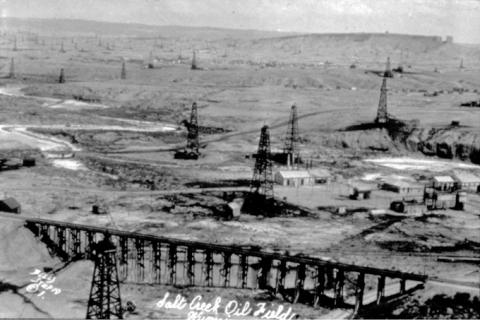
But the largest, most significant oil field in Wyoming in the early 20th century was in northern Natrona County—the Salt Creek field about 40 miles north of Casper. One early speculator, William Fitzhugh, who later donated cash and a collection of fishing and hunting books to the American Heritage Center at the University of Wyoming, supposedly gained his oil claims in the Salt Creek area by trading gold-mining prospects in the Snowy Range to Stephen W. Downey.
Downey was the Laramie lawyer influential in the Territorial decision to locate the university in that town. He made nothing from the gold prospects, but Fitzhugh gained a fortune from the Salt Creek oil.
Oil wells were already in production at Salt Creek in 1908 when H. L. “Dad” Stock took a chance on drilling in a nearby formation just northwest of the company-owned town of Midwest. The result was the “Stock gusher.” When it rumbled in, it spewed oil high above the derrick, covering the prairie for hundreds of feet around when the oil rained down.
Stock made a fortune from the strike, lost it and made another one in oil in the southwest before turning operations over to his son, Paul Stock. The younger Stock, mayor of Cody in the 1940s, was said to have been the individual shareholder with the largest stake in Texaco after he sold his firm to the giant multinational company. The Stock Foundation remained one of the state’s largest philanthropic foundations for many years.
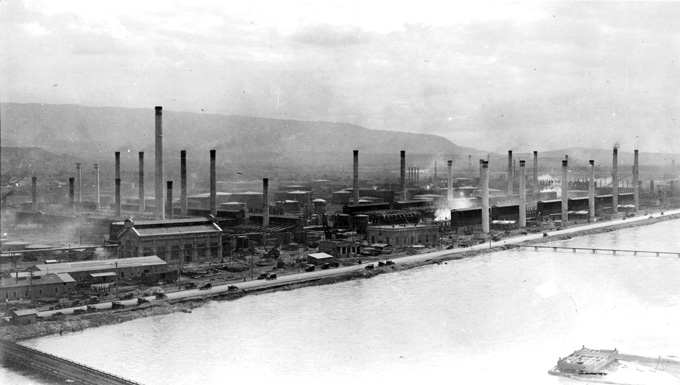
Changing the land law
Most of these first oilfields in Wyoming were discovered on public lands. Under the federal government laws at the time, an oil “prospector” could locate a “provable” oil claim on federal lands, pay a minimal filing fee and hope for a strike. If he had struck oil on private land, he was required to pay the landowner a royalty, but if he found oil on a federal claim, his production belonged entirely to him, and he paid the government nothing.
Congress changed the law, however, and with passage of the Oil and Gas Leasing Act in 1920, oilmen no longer could “claim” oil on federal lands. They could lease such lands, paying royalties for production to the federal government as though it were any other landowner.
Through the influence of several Wyoming members of Congress, the federal government was required to turn back part of the royalties from oil produced on federal lands to the state where the oil was produced. For many years, Wyoming state government enjoyed mineral royalty payments for oil found on federally owned land in the state. Federal mineral royalties, resulting now from coal and trona as well as oil production, remain an important source for state revenues today.
Teapot Dome
In the early 1920s, what became known as the Teapot Dome scandal, named for an oil field near Salt Creek, broke on the national scene. It was the most serious government-corruption scandal prior to the Watergate affair of the 1970s. The Teapot Dome field was owned by the U.S. Navy as a reserve fuel supply for its ships.
Albert Fall, a former U.S. senator from New Mexico by then secretary of Interior for the Warren G. Harding administration, was eventually convicted of accepting bribes from oilmen for allowing them to drill illegally in the reserve. Fall was sent to federal prison; the oilmen were acquitted of making the bribes, but one of them, Harry Sinclair—the same Harry Sinclair who later bought Parco and named it for himself—served time on other related federal charges.
The Depression
Throughout the rest of the 1920s, when Wyoming agriculture and many of the banks that financed it faced economic ruin, the oil industry remained a bright spot in the state’s economy. Oil company profits finally began to falter when the rest of the country was plunged into the Great Depression in the wake of the October 1929 stock market crash.
Oil prices had peaked in 1920 at a national average of around three dollars per 42-gallon barrel. A report from northern Wyoming soon after the crash noted that a customer could buy a barrel of crude oil at Salt Creek for only 19 cents!
Faced with declining prices, oil companies agreed on various measures to alleviate “ruinous” competition. One of the more successful measures was a pricing system known as “Tulsa-plus.” Gasoline, regardless of where it was refined, had to be sold with the additional cost that the wholesaler would have had to pay if the gasoline had been produced in Tulsa, Okla. Wyomingites were furious with that system and high gasoline prices generally. The prices were higher in oil refinery towns like Casper than in other places far from oil refineries.
In the early 1930s, gasoline pricing became a campaign issue in Wyoming gubernatorial races. State attorneys general began a series of suits against companies for inflating gasoline prices to Wyoming consumers. The suits were unsuccessful although the adverse publicity apparently served as a brake on further price increases.
As the 1930s continued, the economic depression extended into the oil fields of Wyoming, not lifting until Allied demands for oil brought price rebounds just before World War II.
In the meantime, consumers welcomed having natural gas piped to their homes in many Wyoming towns. Laramie’s first natural gas line opened in February 1933, but Greybull residents had been enjoying such service since 1908. It was the first town in the state to have home furnaces fueled by natural gas piped in from nearby wells.
The first interstate oil pipeline from Wyoming, meanwhile, was built from Lance Creek in eastern Wyoming’s Niobrara County to Denver in 1938.
World War II
By the beginning of World War II, oil refineries of various sizes operated in many Wyoming towns, including Cody, Lusk, Thermopolis, Newcastle, Laramie and Cheyenne. It was in the latter city that the oil refinery played a key role in production of aircraft fuel. Frontier Refinery’s 100-octane fuel plant helped supply American airplanes with needed high-quality gasoline.
Existing refineries and fields, along with other producing fields established during the war, supplied petroleum products for the American ships, planes and tanks that would help the Allies win the war.
Postwar consolidation
After the war, another strong decade of production brought expansion of existing operations. At the same time the company towns of Hamilton Dome, Grass Creek, Lance Creek, Bairoil, Midwest and Sinclair either diminished in population or became independent incorporated towns by the 1950s.
The industry since World War I always had multinational players. Just two firms, in fact—Standard and Ohio Oil—controlled 95 percent of all Wyoming’s production in 1923. After World War II, however, more multinationals bought existing smaller companies or expanded operations into the Wyoming oil scene.
Production continued strong, peaking both nationally and in Wyoming in 1970. Various schemes proposed to boost oil production made little headway during the decade. One was a jointly sponsored proposal by the Atomic Energy Commission (now the Nuclear Regulatory Commission) and El Paso Natural Gas to use nuclear weapons to release gas and petroleum “locked” into tight sandstone formations under Sublette County. The so-called Project Wagon Wheel met with considerable local opposition and was eventually shelved.
Most refineries in the state closed in the 1970s and 1980s. These included Husky’s refinery at Cody and Empire State Oil Company’s Thermopolis refinery. In 1991, even the Standard Oil (Amoco) refinery at Casper—once the world’s largest—closed, and the land was later converted into a municipal golf course and office park.
Epilogue
Although the fields in Wyoming, for the most part, are aging, oil production remains important to the state’s economy as it enters the second decade of the 21st century. However, oil is no longer the primary energy mineral produced here.
Coal-bed methane—methane gas trapped in underground coal seams and once considered a waste product until cost-efficient means of recovery and distribution were developed in the 1980s—has caused an economic boom in several areas of Wyoming, including Sublette County in the southwest and the Powder River Basin in the northeast.
Natural gas production boomed in the 1990s and 2000s in Sublette County’s Jonah Field and Pinedale Anticline and an even larger development is now proposed for gas fields in northeastern Fremont County near Lost Cabin and Lysite.
But even with the new value in natural gas and coal-bed methane, coal remains king just as it was in Wyoming in the 19th century before the invention of the automobile and diesel locomotive. Since the late 1980s, Wyoming has led the nation in coal production. The state’s ranking in oil, while still in the top dozen, has slipped since the heyday of Wyoming oil in the 19-teens and 1920s and the years of the “second oil boom” after World War II.
Resources
 Click here to see Phil Roberts talk more about the history of oil on Wyoming PBS.
Click here to see Phil Roberts talk more about the history of oil on Wyoming PBS.
Primary Sources
- Argo Oil Corporation. Collection 514. American Heritage Center, University of Wyoming, Laramie, Wyo.
- Carter Oil Company. Records. Collection 562. American Heritage Center, University of Wyoming.
- Consolidated Royalty Oil Company. Records. Collection 9618. American Heritage Center, University of Wyoming.
- Hill, Charles S. Papers. Collection 4432. American Heritage Center, University of Wyoming.
- Roberts, Harold. Papers. Collection 506. American Heritage Center, University of Wyoming.
- Sullivan, Eugene J. Papers. Collection 3586. American Heritage Center, University of Wyoming.
- Wall, Tom J. Life in the Shannon and Salt Creek Oil Field. Philadelphia: Dorrance, 1973. An excellent first-hand account.
Secondary Sources
- Deffeyes, Kenneth S. Beyond Oil: The View from Hubbert’s Peak. New York: Hill and Wang, 2006.
- Giddens, Paul H. Standard Oil Company (Indiana): Oil Pioneer of the Middle West. New York: Appleton-Century-Crofts, 1955.
- Greenburg, Daniel W. Midwest: Leader in the Rocky Mountain Region. Chicago: Standard Oil, 1930.
- “Historic Crude Oil prices, 1861-Present.” Chart Bin, accessed Aug. 30, 2012 at http://chartsbin.com/view/oau.
- McCartney, Laton. The Teapot Dome Scandal: How Big Oil Bought the Harding White House and Tried to Steal the Country. New York: Random House, 2008.
- Mackey, Mike. Black Gold: Patterns in the Development of Wyoming's Oil Industry. Powell: Western History Publications, 1997.
- ___________. “Cheyenne’s 100-Octane Plant.” In Readings in Wyoming History, 4th ed. Phil Roberts, ed. Laramie, Wyo.: Skyline West Press, 2004, 125-131.
- Roberts, Harold D. Salt Creek, Wyoming: The Story of a Great Oilfield. Denver: Midwest Oil Co., 1956.
- Rosenberg Historical Consultants. Tour Guide: Salt Creek Oil Field, Natrona County, Wyoming. Casper, Wyo.: Natrona County Commission, 2003.
- Spence, Hartzell. Portrait in Oil: How the Ohio Oil Company Grew to Become Marathon. New York: McGraw-Hill, 1962.
- Stratton, David H. Tempest Over Teapot Dome. Norman, Okla.: University of Oklahoma Press, 1998.
- White, Kris A. “Evolution of Roads Across Southern Wyoming.” In Readings in Wyoming History. 4th ed. Phil Roberts, ed. Laramie, Wyo.: Skyline West Press, 2004, 96-109.
- Yergin, Daniel. The Prize: The Epic Quest for Oil, Money and Power. New York: Simon/Schuster, 1991.
Illustrations
- The geological diagram of trapped oil is from Wyoming Tales and Trails. Used with thanks.
- The photo of oil-soaked roughnecks in the Salt Creek field is from the Salt Creek Oil Field Photo File, American Heritage Center, University of Wyoming. Used with permission and thanks.
- The Wyoming State Archives 1903 J.E. Stimson photo of wooden derricks in Uinta County is from an online photo gallery of Stimson photos maintained by the Wyoming State Historic Preservation Office. Used with thanks to both institutions.
- The black-and-white photo of the Salt Creek field, 1923, is by Bell’s studio, from the Amoco Refining Company collection, Casper College Western History Center. Used with permission and thanks.
- The photo of the Standard Oil refinery in Casper in the 1920s is from the Blackmore Collection, Casper College Western History Center. Used with permission and thanks.
